Discrete Element Method - Advantages of coupling Passage®: DEM and FLOW
CFD Software
By coupling PASSAGE®
DEM
and FLOW software a variety of problems can be solved which
can not be treated by using either one model individually. This capability
allows modeling of liquids, gases, solid particles and their mixtures for
many industrial problems in both micro and macro scales. It can be applied
to process modeling of mixing, wetting, coating, filtration, fermentation
and filling operations for applications in food, pharmaceutical, chemical,
metals, plastics, glass, ceramics, powders processing and emission control.
DEM and FLOW modules can be coupled in
a variety of ways depending on the application:
- Many mixtures or two-phase flows require modeling of microscopic
behavior of the material (e.g. air flow around solid particles. In this
case DEM and FLOW modules are executed
in parallel.
- Industrial applications of particle flows usually involve billions
of particles which cannot be efficiently modeled by DEM
models. On the other hand, flow codes can not predict the material
properties of mixtures or particle flows in sufficient detail due to the
lack of accurate material models. In this case, DEM
model is used to determine material properties for the FLOW
model.
Coupling of Passage®/
DEM and FLOW Software
Example: Fluidized Bed Granulation of Tablets
|
| Flow Model - Air Velocity |
|
DEM Model Particles |
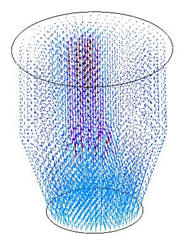 |
|
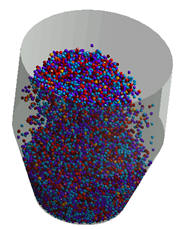 |
|
contact
Technalysis for licensing options and consulting services. |
| Coupling of
Passage®/ DEM and FLOW Software brochure (.pdf) |
Example:
Mixing of Powders
|
A. DEM Model
|
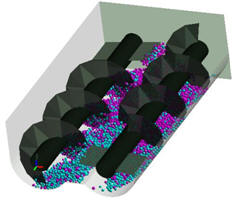 |
|
|
Mixing of powders for industrial
applications, involves calculation of the motion of
large number of particles.
DEM models can be used to simulate
applications with smaller number of particles in the
laboratory.
Limited number of particles
Input: Microscopic properties of material
Output: Motion of each particle |
|
|
|
|
B. Simple Models
|
|
|
|
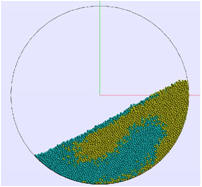 |
|
|
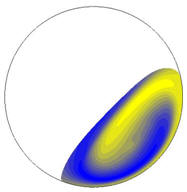 |
DEM Model
|
|
|
Flow Model
|
Simple experiments can be designed which are modeled
by using both DEM and FLOW.
Microscopic material properties are used for the
DEM model. Macroscopic material
properties are then determined by comparing the
DEM and FLOW
solutions for simple cases.
Input: Microscopic material properties for DEM model
Output: Macroscopic material properties for FLOW
model
|
|
|
|
|
C. Flow Model
|
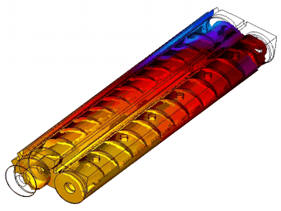 |
After determining the
material properties for particle flow, FLOW
model is used for solving industrial problems.
Billions of Particles
Input: Material Properties for FLOW
model
Output: Material Flow: for the application with
large number of particles
|
|
Contact us for a more detail discussion of
Technalysis' engineering capabilities. |
|
|
|
|
|
| more on
High-Shear Granulation and Technalysis' granulation
process capabilities |
Passage Licensing Options:
Technalysis offers
various licensing options and support to fit your needs
and budget. Contact us to discuss your needs.
E-mail or call 317-291-1985